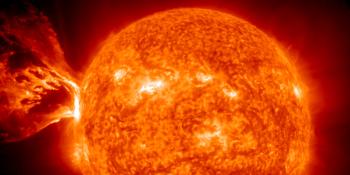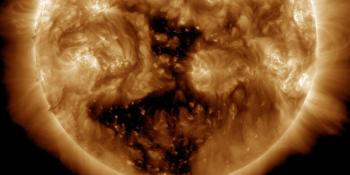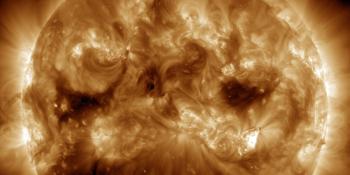Viewing archive of Thursday, 1 December 2016
Daily bulletin on solar and geomagnetic activity from the SIDC
Issued: 2016 Dec 01 1230 UTC
SIDC Forecast
Solar flares
C-class flares expected, (probability >=50%)
Geomagnetism
Quiet (A<20 and K<4)
Solar protons
Quiet
| 10cm flux | Ap | |
|---|---|---|
| 01 Dec 2016 | 084 | 003 |
| 02 Dec 2016 | 083 | 003 |
| 03 Dec 2016 | 082 | 003 |
Bulletin
NOAA 2615 remained the only flare-active sunspot region on the disk. It produced the two sole C-class events of the period, a C1 flare at 15:07UT and a C2 flare at 15:25UT. NOAA 2612 and NOAA 2614 are further decaying and were quiet. The filament north of NOAA 2612 (N15W15) erupted between 13:30 and 14:30UT. Coronal dimming was observed, but the coronagraphic images do not show an obvious coronal mass ejection. In H-alpha, a nearby filament blob (N35W15) quietly disappeared in the subsequent hours. No earth-directed coronal mass ejections (CMEs) were observed in available coronagraphic imagery. The greater than 10MeV proton flux was at nominal levels.
There's still a chance on an isolated C-class flare.
Solar wind parameters are at nominal levels, with wind speed values mostly between 340 and 370 km/s and Bz fluctuating between -4 nT and +5 nT. The interplanetary magnetic field was mostly directed away from the Sun. Solar wind parameters are expected to remain at nominal values. A small positive coronal hole (S15W00) is near the central meridian and may mildly affect the earth-environment late on 4 or on 5 December.
The geomagnetic field was at quiet levels and is expected to remain so.
Today's estimated international sunspot number (ISN): 057, based on 12 stations.Solar indices for 30 Nov 2016
| Wolf number Catania | /// |
| 10cm solar flux | 084 |
| AK Chambon La Forêt | 006 |
| AK Wingst | 002 |
| Estimated Ap | 002 |
| Estimated international sunspot number | /// - Based on /// stations |
Noticeable events summary
| Day | Begin | Max | End | Loc | Strength | OP | 10cm | Catania/NOAA | Radio burst types | |
|---|---|---|---|---|---|---|---|---|---|---|
| None | ||||||||||
Provided by the Solar Influences Data analysis Center© - SIDC - Processed by SpaceWeatherLive
All times in UTC
Current data suggests there is a slight possibility for aurora to appear at the following high latitude regions in the near future
Iqaluit, NUNuuk
Reykjavik
Latest news
Latest forum messages
Support SpaceWeatherLive.com!
A lot of people come to SpaceWeatherLive to follow the Sun's activity or if there is aurora to be seen, but with more traffic comes higher server costs. Consider a donation if you enjoy SpaceWeatherLive so we can keep the website online!

Latest alerts
Thursday, 10 April 2025
23:00 UTC - Geomagnetic activity
Active geomagnetic conditions (Kp4) Threshold Reached: 22:47 UTC
20:45 UTC - Hemispheric Power Index
The OVATION model predicts the Hemispheric Power Index to reach 50GW at 21:37 UTC
01:45 UTC - Geomagnetic activity
Active geomagnetic conditions (Kp4) Threshold Reached: 01:41 UTC
Wednesday, 9 April 2025
08:12 UTC - Hemispheric Power Index
The OVATION model predicts the Hemispheric Power Index to reach 76GW at 08:57 UTC
Space weather facts
| Last X-flare | 2025/03/28 | X1.1 |
| Last M-flare | 2025/04/08 | M1.5 |
| Last geomagnetic storm | 2025/04/06 | Kp5 (G1) |
| Spotless days | |
|---|---|
| Last spotless day | 2022/06/08 |
| Monthly mean Sunspot Number | |
|---|---|
| March 2025 | 134.2 -20.4 |
| April 2025 | 144.7 +10.5 |
| Last 30 days | 138.8 +1.3 |




